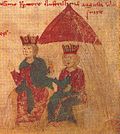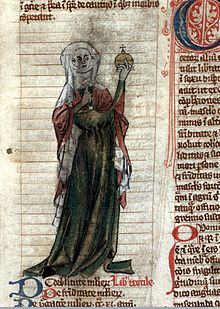List of 999 women of the Heritage Floor / Trota
This list describes the place settings for Trota on the table of Judy Chicago's art installation The Dinner Party . It is part of the list of 999 women on the Heritage Floor who are assigned to the respective place settings on the table. The names of the 999 women are on the tiles of the Heritage Floor, which is arranged below the table and belongs to the art installation.
description
The installation consists of a three-sided table, each with 13 historical or mythological personalities, thus a total of 39 people, from prehistory to the women's rights movement . These people were assigned a place setting at the table, consisting of an individually designed table runner, an individually designed plate, a goblet, knife, fork, spoon and serviette. The first page of the table is devoted to prehistory up to the Roman Empire , the second to Christianization up to the Reformation and the third from the American Revolution to the women's movement. Each place setting on the table is assigned additional personalities who have received an entry on the tiles of the Heritage Floor, which occupies the space under the table and the center of the space between the sides of the table. This list includes the personalities assigned to the Trota table setting. Your seat is on the second side of the table.
Hints
In addition to the names as they are used in German transcription or in scientific usage, the list shows the spelling chosen by Judy Chicago on the tiles.
The information on women who do not yet have an article in the German-language Wikipedia is referenced by the individual references listed under comments . If individual information in the table is not referenced via the main article, additional individual references are given at the relevant point. If there are any discrepancies between the information provided in Wikipedia articles and the descriptions of the work of art on the Brooklyn Museum website , this will also be indicated under Comments.
Place setting for Trota
Very little is known about the life of the Trota . She is said to have been the wife of Johannes Platearius, also a doctor. If so, the doctors Matthaeus Platearius and Johannes Platearius the Younger are her sons. However, this is also doubted in science. Trota was part of the Salerno faculty as a general practitioner . She wrote several treatises on medical practice. When she was Platerius's wife, she worked with him and their sons on the medical encyclopedia Practica brevis . The main text of the school of Salerno, De aegritudinum curatione from the 12th century, contains medical textbooks by the school's seven grandmasters, including the Trotula ensemble and the tract Practica brevis by Johannes Platearius the Younger.
The historical person Trota can be safely proven by the discovery of a collective manuscript from the 13th century ( Collectio Salernitana ) by John F. Benton in Madrid in 1985, which contains the general medical work Practica secundum Trotam written by Trota around 1150 .
The name of a collective medical publication in the field of gynecology from the 12th century, which was regarded as a standard work until the 15th century, in Germany and England until the 16th century, is called Trotula . At least one of the three contained fonts can be traced back to Trota. The Trotula ensemble includes three works, the authors of which are anonymous in the first and third cases.
The first script is Liber de sinthomatibus mulierum . It has influences from Arabic medicine and is based heavily on the Zād al-musāfir of Ibn al-Jazzar , which Constantine the African translated in the late 11th century. The main source for Ibn al-Jazzar was Galenus of Pergamon , Hippocrates of Kos , Oribasius, Pedanios Dioskorides , Paulus and Justinus are also cited.
The second font is entitled De curis mulierum . This writing is attributed to Trota and is also known as Passionibus mulierum curandorum or Trotula major . In her work she emphasizes the importance of cleanliness, a balanced diet and physical activity. At the same time, it warns of stress and restlessness. She works with uncomplicated means and recipes that are affordable even for members of the common people.
In the third publication De ornatu mulierum , skin diseases and cosmetics are discussed, this document is also known as Trotula minor .
As a doctor, she relates the place setting for Trota on the dinner party table to birth. The central element of the table runner is a picture of the tree of life . It stands for Trota's profession of gynecologist. The runner is embroidered using the trapunto technique. This quilting technique goes back to 11th century Sicily. The white fabric of the runner is reminiscent of a diaper. It works like a quilt that creates a visual connection to the well-known baby blanket. The initial letter "T" on the front of the runner is decorated with a bird of the tree of life. The plate shows a birth picture and curved shapes that are reminiscent of the caduceus , a symbol for medicine and doctors. These snake shapes also refer to the Aztec fertility goddess, who served as the patroness of midwives. Chicago chose the snake motif "because of its historical association with feminine wisdom and healing powers".
| Surname | Spelling on the tile | Date of birth | cultural spatial assignment | Remarks | image |
|---|---|---|---|---|---|
| Abella | Abella of Salerno | Middle of the 14th century | Kingdom of Naples , Salerno | Classes in general medicine at the Schola Medica Salernitana , the first medical school in Europe. She specialized in embryology and published two papers. | |
| Adelberger | Adelberger | 8th century | Lombardy | Doctor, member of the lay healers' guild. | |
| Æthelthryth | Etheldreda | at 636 | Kingdom of East Anglia | Anglo-Saxon saints . |

|
| Ageltrude | Ageltrude Benevento | 9th century | Eastern Franconia | Empress and Queen of Italy, prevailed against Pope Formosus , who was dishonorably thrown into the Tiber twice after his death to secure the crown for her son. | |
| Aloara | Aloara | 10th century | Eastern Franconia | After the death of her husband Pandolf in 981, she ruled Capua until her death in 992. | |
| Bertha von Sulzbach | Bertha of Sulzbach | around 1110 | Byzantine Empire | As the wife of Manuel I. Komnenos, the only German on the Byzantine imperial throne. | |
| Bettisia Gozzadini | Bettisia Gozzadini | 1209 | Holy Roman Empire | Lawyer who taught at the University of Bologna around 1239 . She is considered the first woman to have taught at a university. |

|
| Engelberga | Angelberga | 9th century | Eastern Franconia | Empress as the wife of Emperor Ludwig II , abbess of the monastery of San Sisto in Piacenza, which she founded . | |
| Francesca of Salerno | Francesca of Salerno | 14th century | Kingdom of Naples , Salerno | Doctorate in surgery in 1321 from the medical faculty of Salerno , which was a training center for many female doctors in the fourteenth century and which had accepted women from the start. | |
| Constance of Sicily | Constantia | 1154 | Kingdom of Sicily | Queen of Sicily in her own right and the last of the Hauteville family on the Sicilian throne. |

|
| Odilia | Odilla | around 660 | Franconian Empire , Alsace or Burgundy | Abbess , is venerated as the patron saint of Alsace and eyesight . |

|
| Popess Johanna | Pope Joan | N / A | Late Middle Ages | Fictional, learned woman posing as a man who is said to have officiated as Pope . |

|
| Rachel | Rachel | around 1070 | Frankish Empire , Troyes | Rachel was one of the three daughters of the well-known Talmudic scholar Schlomo Jizchaki, known as Rashi . All three daughters were self-taught women and married the most gifted disciples of Rashi. | |
| Sara de Sancto Aegidio | Sarah of St. Gilles | 14th century | Champagne | A medieval doctor. Her practice and medical knowledge is known through a contract with her student. This document is the earliest and best known example of this type of teacher-student contract. | |
| Stephanie de Montaneis | Stephanie De Montanei | 13th century | Holy Roman Empire , Lyon | Doctor in Lyon at a time when it was difficult for women to enter the medical field. It is believed that she was trained by her father, Étienne de Montaneis. | |
| Theodora I of Tusculum | Theodora the Senatrix | 8th century | Frankish Empire , Tusculum | Wife of the Roman senator and aristocratic leader Theophylact I of Tusculum and with the titles senatrix or vestaratrix involved in his rule in Rome . | |
| Urraca | Urraca | 1148 | Portugal | Portuguese Infanta , daughter of Afonso I , 1st King of Portugal and his wife Mathilde . She married Ferdinand II. The marriage did not prevent her father from declaring war on her husband, which eventually led to the annulment of the marriage in 1175. |

|
| Walburga | Walpurgis | at 710 | Frankish Empire | Anglo-Saxon Benedictine nun and abbess of the Heidenheim monastery . Walburga is believed to be the daughter of the West Saxon Christian King Richard of Wessex and is considered by most sources to be a niece of St. Boniface . In the Catholic Church she is venerated as a saint . |

|
- Individual evidence
- ↑ Brooklyn Museum: Trotula. In: brooklynmuseum.org. Retrieved October 20, 2019 .
- ^ Judy Chicago: The Dinner Party: From Creation to Preservation. Merrell, London 2007, ISBN 978-1-85894-370-1 , p. 116.
- ^ Marilyn Ogilvie, Joy Harvey, The Biographical Dictionary of Women in Science: Pioneering Lives From Ancient Times to the Mid-20th Century . Routledge, 2003, ISBN 1-135-96342-8 ( books.google.de ).
- ↑ Brooklyn Museum: Aloara. In: brooklynmuseum.org. Retrieved October 20, 2019 .
- ↑ Brooklyn Museum: Bettisia Gozzadini. In: brooklynmuseum.org. Retrieved October 20, 2019 .
- ^ Brooklyn Museum: Francesca of Salerno. In: brooklynmuseum.org. Retrieved October 20, 2019 .
- ↑ Brooklyn Museum: Rachel (Trotula group). In: brooklynmuseum.org. Retrieved October 20, 2019 .
- ^ Brooklyn Museum: Sarah of St. Gilles. In: brooklynmuseum.org. Retrieved October 20, 2019 .
- ↑ Muriel Joy Hughes: Women healers in medieval life and literature / . New York:, 1943, p. 141 .
- ↑ Brooklyn Museum: Urraca. In: brooklynmuseum.org. Retrieved October 20, 2019 .
Web links
- Brooklyn Museum, Trota
- The Dinner Party on the website of Through the Flower , Judy Chicago's non-profit organization
